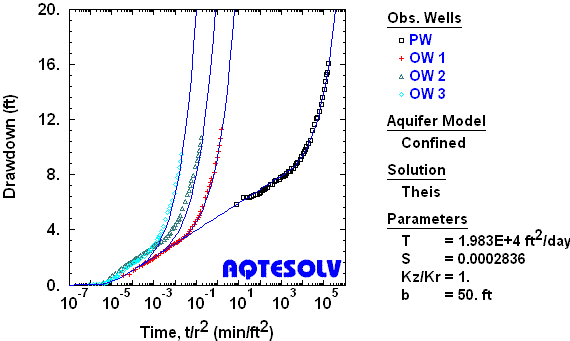Bounded Aquifers
"The families of curves are terrific and do everything I could possibly ask. Absolutely super!"
--William Hotchkiss, Ph.D., NRCE, Inc.
AQTESOLV now incorporates a powerful tool for analyzing pumping tests in bounded aquifers. Not only can you simulate simple problems with single boundaries, but you also can evaluate up to four boundaries!
The method of images is a well-known technique for mathematically incorporating the effect of boundaries into the drawdown calculations for a bounded aquifer. For single boundaries such as a stream or a fault, it is straightforward to introduce the image well needed to represent the boundary; however, when two parallel boundaries are involved (e.g., channel aquifers), the number of image wells required approaches infinity. Clearly, manual generation of these image wells would be extremely tedious.
Fortunately, AQTESOLV simplifies the evaluation of complex boundary problems with a tool that automatically generates the location and number of image wells necessary to compute drawdowns accurately for a specified set of boundaries.
- constant-head and no-flow boundaries
- adjustable boundary locations
- automatic image well generation
Channel (Strip) Aquifers
Aquifers may occur in long narrow valleys or buried channels. Simulating two parallel no-flow boundaries for channel aquifer configurations requires the use of an infinite array of image wells.
AQTESOLV simplifies the analysis of channel aquifers by automatically generating the required image wells for you as shown in Figure 1.

Figure 2 shows a comparison of AQTESOLV to the Vandenberg (1977) solution for a constant-rate pumping test in a nonleaky confined channel aquifer. The log-log plot approaches a constant 1:2 slope for 1/u > 1000 which is diagnostic of late-time linear flow in a nonleaky confined channel aquifer.

You may use any virtually any pumping-test solution in AQTESOLV to simulate channel aquifer conditions.
See also: pumping tests in bounded aquifers